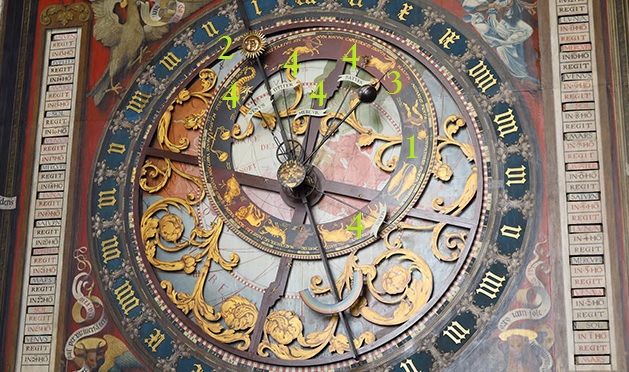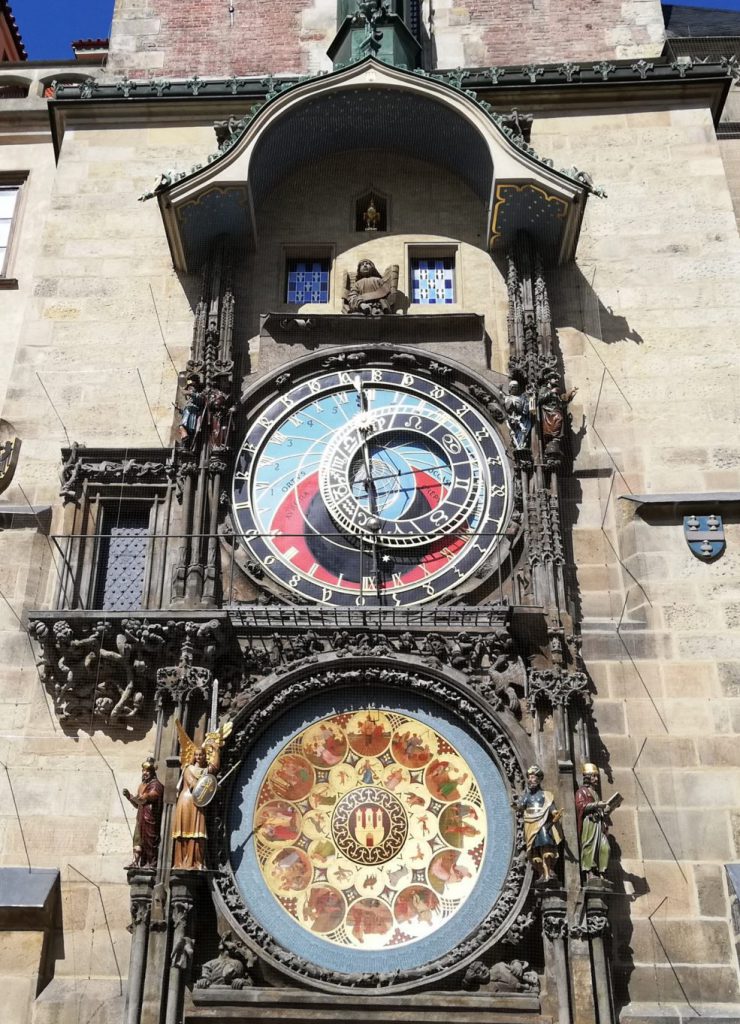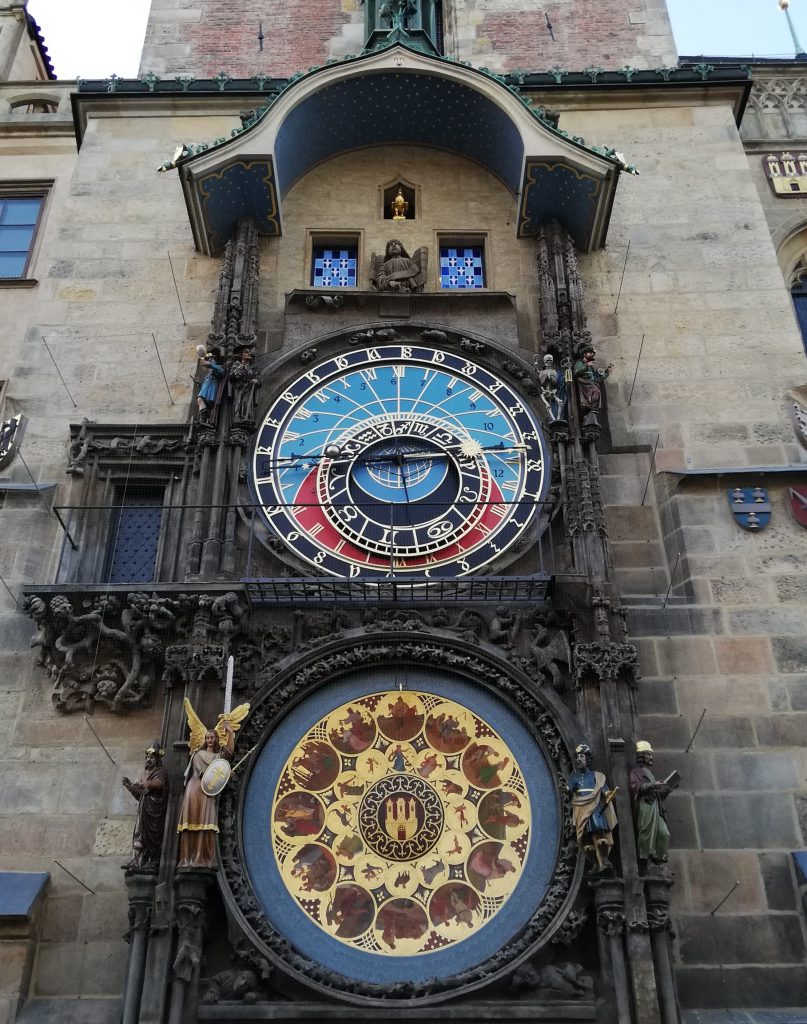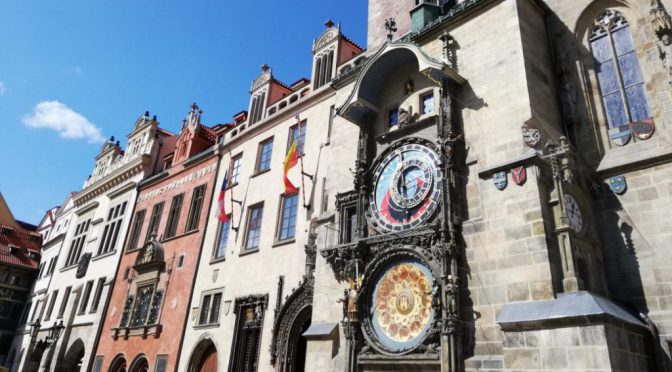1. Introduction
For plenty of reasons, Prague is one of the most popular tourist destinations in Europe, and if you had the pleasure to spend a few days in the capital of the Czech Republic (aka Czechia) for a sightseeing tour you would certainly visit the Old Town Square (Staroměstské náměstí) in the city center with its scores of splendid and centuries old buildings.
At the southwestern corner of the Old Town Square you will prod at a particularly striking piece of architecture: the Old Town Hall (Staroměstská radnice) with its famous astronomical clock (Pražský orloj).
Big and prominent astronomical clocks are precious objets de prestige.
However, they incite the spectator’s interest not just because of their medieval or contemporary artistic expression.
First and foremost, they bear witness to the technical and scientific bloom during the late middle ages, the Renaissance and the dawn of the modern era.
The purpose of astronomical clocks, aside from announcing the time, is to depict the course and the current position of the sun and the moon.
And, as addition in rarer cases, charting the course of the planets in the solar system, the movement of the fixed star sky, as well as further astronomical information dependent on the geographic location of the clock1 .
In the following, I want to provide some background information about these engineering masterpieces, and illustrate afterwards the astronomical clocks in Münster (Germany) and Prague (Czechia).
2. Astrolabium clocks
Both the clock in Münster and the clock in Prague are so-called Astrolabium clocks.
Astrolab(ium) was the name of medieval devices of different sizes which were developed and used for astronomical measurements.
Every Astrolab consists in principle of four parts:
A base area (mater), the planisphere, a wheel (rete) and an eyepiece.
The planisphere represents the most important circles of the celestial sphere for a particular point of observation.
For the case of a fixed position of the astronomical clock, the planisphere is not an interchangeable device (like in mobile clocks) but is painted straightly on the mater (where also geographical information is to be found).
The rete (Latin for net) is mounted on the mater (Latin for mother) and the planisphere, but unlike those parts the rete is propelled by the clockwork. That means more precisely it rotates according to the movements of the fixed star sky2 .
The eyepiece is solely a mandatory device if the clockwork doesn’t perform the movements of the celestial bodies.
It is not required for the astronomical clocks in Prague or Münster. The observer doesn’t have to sight the stars and to adjust the clock hands himself.
3. Astronomical clock in Münster
Heavily destroyed in the 2nd World War and (with a few exceptions) completely rebuilt in its original appearance during the 1950s, the city of Münster in North Rhine-Westphalia contains beside many other intriguing sights an imposing astronomical clock in the south-eastern parts of the St.-Paulus-Dom (the main cathedral).
I worked near Münster in 2013 and had the opportunity to visit the cathedral and to take a look at the clock (unfortunately my photos are lost).
3.1 History of the astronomical clock
The astronomical clock in the St.-Paulus-Dom was installed in 1540 as a replacement for a parent timepiece which was destroyed during the Münster rebellion around 1535 (Täuferreich von Münster)3 .
The ingenious mechanisms and the astronomical components were created by means of contemporary knowledge about mathematics, geography, astronomy, and blacksmith artistry.
That implicates, for instance, that only the five then known planets Mercury (Merkur), Venus, Mars, Jupiter, and Saturn had (and still have) hands on the clock-face.
The clock-mechanism was repeatedly modernized in the course of the epochs, by virtue of growing scientific knowledge (the pendulum-isochronism discovered by Galileo Galilei, for example) and the inevitable technological progress (such as the development of improved escapements), but also out of necessity due to many wear-prone elements in the clockwork.
The last extensive reconstruction of the clockwork was in 1930 (see below).
3.2 Description of the clock

Eccentric to the rotation axis of the rete you can recognize the zodiac (1) with its twelve signs as a component of the wheel (rete).
The most conspicuous hand is the sun- or hour hand (2). It reaches from one edge of the clock face to the other edge, and carries on one side a small sun and on the other side a rainbow (the sun and the rainbow are in opposition to each other just as in nature).
The sun moves anticlockwise across the clock face and needs 24 hours for one complete circulation, since it is representing the actual sun course in the sky.
Additionally, the sun (with the sun face always upright) is moving alongside the hand and illustrates the change of seasons over the course of the year with this motion. This small object’s movement is arranged in that manner that it stands in the right zodiac sign according to the momentary observable position in the sky. During the course of one year, every zodiac sign will be passed through. Then it starts over again.
The moon hand (3) also represents the actual conditions in the sky: it rotates a bit slower than the sun hand.
The planet hands (which differ in their length and carry a small golden star at their end) illustrate the in the 16th century known planets: Mercury (Merkur), Venus, Mars, Jupiter, Saturn. Like the moon and the sun hand, they are rotating according to their real movements (except for Mercury, which is fixed to the sun hand) (4).
3.3 Mechanics of the clock
I will merely take a short glimpse at the mechanics of the clock4 .
The last extensive reconstruction of the clockwork of the astronomical clock took place in 1930.
The clockwork consists of numerous interacting cogs with (presumably) no cardinal changes in its basic design since its original creation. The (medieval as well as contemporary) designers put a lot of effort in calculating the couplings and the correct gear-ratios in particular since the precise movement of the planet hands is tricky.
An electronic motor powers the entire mechanism. These motors succeeded mechanical power sources (weights), used during the first centuries of the clock’s existence.
Every day at 12 o’clock, the clockwork activates a motor for the Glockenspiel (chimes) and for the Umgang der heiligen drei Könige (Procession of the three Kings), a small rotating platform on the top of the astronomical clock. It is no surprise that this magnificent exhibition of religious characters attracts a rush of visitors every day at noontime.
4. Astronomical clock in Prague (Pražský orloj)
Prague is the capital of the Czech Republic with 1.3 million inhabitants, situated at the river Vltava (Moldau).
Luckily almost untouched by the 2nd World War, the city possesses an incredible amount of cultural monuments and sights which attracts countless numbers of tourists, especially in the summer months.
One of these sights is the Old Town Hall on the Old Town Square, as highlighted in the foreword of this article.
4.1 History of the astronomical clock
The astronomical clock mounted on the Old Town Hall exists since the early 15th century.
Like other prominent astronomical clocks (and mechanical clocks in general), the clockwork and the exteriors are prone to wear and deterioration. The most extensive and expensive maintenance procedures had been carried out in the 18th and 19th century.
The clock was also heavily damaged during the final days of the 2nd World War (Prague uprising). Fortunately, it was possible to repair the partially destroyed clock in the years after the war.
4.2 Description of the clock
Note: photos were taken on 14th September 2019. CET is the Central European Time that is the time displayed by the clock.
The Central European Summer Time is one hour ahead. UTC is the Coordinated Universal Time (CET-1).

Unlike the clock in Münster, the Pražský orloj possesses solely a sun and a moon hand.
The sun hand with a gold-plated hand attached at one end charts the local time (represented by the golden Roman numerals), and, what had been more important for the clock designers, imitates the current position of the sun.
The zodiac doesn’t look as ostentatious as the zodiac of the Münster clock, possibly because the timepiece is not an indoor object. Over the course of the year, the small sun on the sun hand will make her way through the zodiac (on 14th September her position was between Leo and Virgo constellation).

5. Epilogue
Writing this article was fun. As an engineering-savvy person I enjoy elaborating subject-matters like this, and I hope you’ve enjoyed reading.
So don’t forget to marvel at the Old Town Hall and the Prague Orloj during your next stay in Prague, with (hopefully) a little better understanding about the mechanisms of the clock.
6. References
6.1 Books
Die astronomische Uhr im Dom zu Münster – ISBN 978-3-402-05984-5
6.2 Footnotes
1 the intention to utilize this information was religious or educational in its nature, beside being just an ornament
2 “movement of a fixed star” is not a contradiction in itself; due to the rotation of the earth and the orbital movement of the earth around the sun these stars are actually not stationary for an observer; but the positions of the stars to one another (their relative movement) is fixed
3 the cathedral had also been partially destroyed during the 2nd World War. The astronomical clock remained unscathed fortunately
4 part of the reason is that I have only one small sketch from a book (see 6.1) which is for obvious reasons not sufficient to acquire a proper understanding of the clockwork-mechanisms
Featured image: Old Town Hall in Prague
